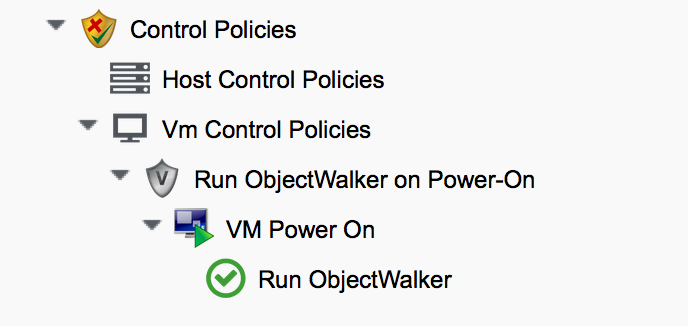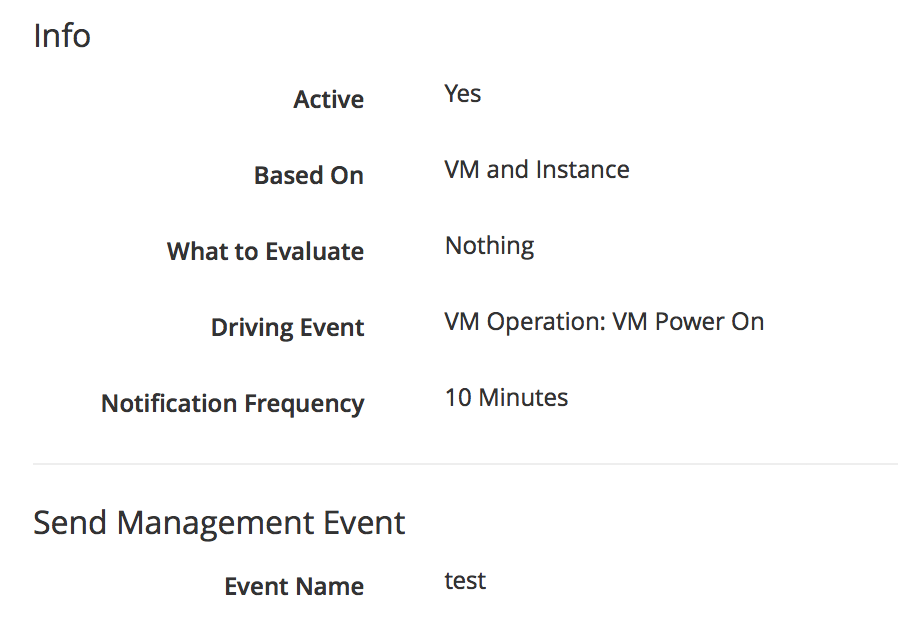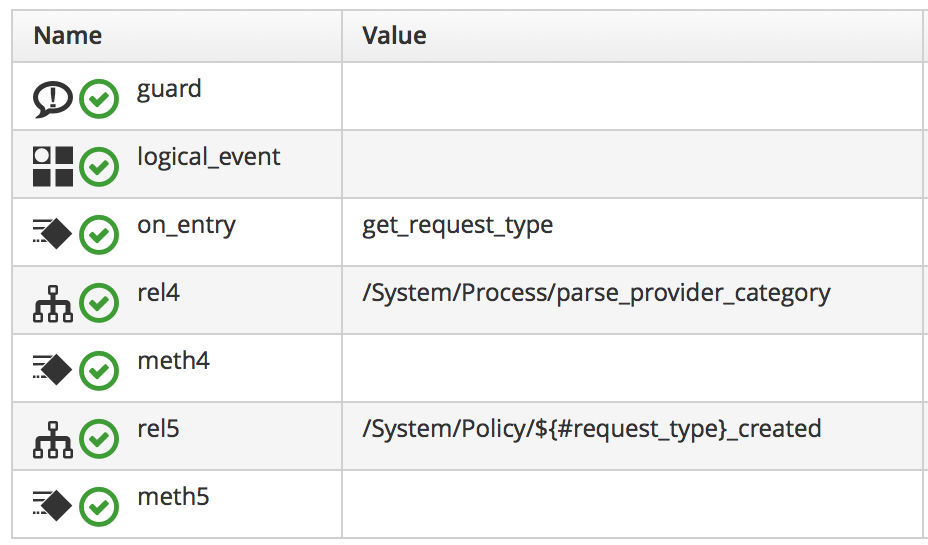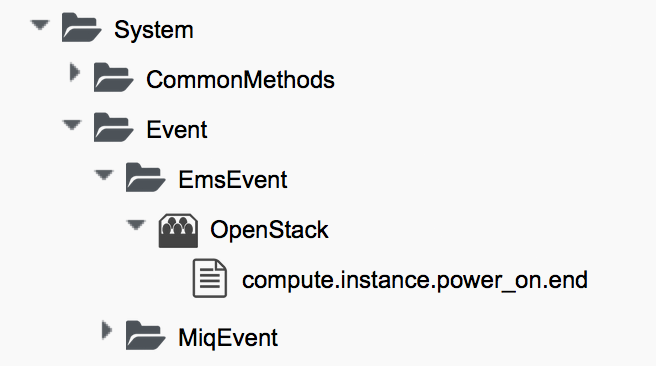
Event Processing
One of the most powerful features of ManageIQ Automate is its capability to process events. ManageIQ can monitor and respond to external (provider) events, such as a virtual machine starting or stopping, or a hypervisor going into maintenance. These events can then be used as triggers for Automate operations. We might wish to initiate a SmartState Analysis scan on a new VMware virtual machine when a VmCreatedEvent event is detected for example. Perhaps we’d like to intercept and cancel a USER_INITIATED_SHUTDOWN_VM event being detected on a critical RHEV virtual machine that we’ve tagged as "do_not_shutdown".
ManageIQ Automate also raises its own events internally, which can then be used as workflow triggers. We see an example of this when we provision a new virtual machine (we cover VM provisioning in Part II of the book). The workflow for provisioning a virtual machine includes an approval stage - we can optionally allow administrators to approve large VM requests - followed by a quota-checking stage to ensure that users are not exceeding their quota. The successful approval of the VM provisioning request results in Automate raising a request_approved internal event. This request_approved event is then used as the trigger to automatically start the quota checking workflow (see Provisioning Quota Management for more details of this workflow).
In this chapter we’ll examine in detail how events are processed by the Automation Engine. This is a 'deep dive' chapter containing useful background information, but can be skipped for now if required. Event handling happens automatically in ManageIQ, and an understanding of the event processing workflow can help us as we advance our Automate skills. In Automation Request Approval we create an entirely new approval workflow, based largely on our knowledge of how events are processed.
To improve the scalability of event handling, particularly with the advent of new providers and provider types, the event processing mechanism has been substantially re-written in ManageIQ Capablanca. We’ll first look at the new component parts of Automate’s event processing, and then we’ll study how external events are caught and internal events are raised and handled.
Event Processing Component Parts
The are several new components involved in processing events in ManageIQ Capablanca, including an event stream object type, the event switchboard, and event handlers.
The Event Stream Object
Events are now handled by an event stream object, derived from a parent EventStream class. An EventStream object is created in response to an external or internal event, and this object is sent to Automate to initiate the event handling process.
Events enter Automate at the /System/Process/Event instance, and this contains a rel5 relationship that redirects the handling of the event into the event switchboard. The root of the event switchboard is at /System/Event. (see Entry Relationship into the Event Switchboard).

The Event Switchboard
The event switchboard is a new set of namespaces, classes, instances and methods, written to handle the processing of events in a scalable manner.
/System/Process/Event contains a rel5 relationship into the switchboard, and this relationship URI comprises three parts; the event namespace, the event source, and the event type. Each is selected from the substitution of a run-time variable:
/System/Event/${/#event_stream.event_namespace} /
${/#event_stream.source} /
${/#event_type}
The substituted values are taken from attributes of the EventStream object representing the event, and the event type.
Event stream mamespace
The ${/#event_stream.event_namespace} part of the relationship translates to one of four event stream namespaces:
-
CustomEvent where we can define our own management event alerts
-
EmsEvent if the event’s origin was an external management system (i.e. a provider). An EmsEvent instance contains all information about its virtual machine, host and provider related to the event
-
MiqEvent if the event’s origin was an internal ManageIQ-initiated Policy event
-
RequestEvent if the event is related to an automation request (e.g. request_created)
These can be seen in Event Stream Namespaces

Event stream source
Within each of the event stream namespaces, are classes that define the event stream source instances. The selection of source class is made from the substitution of the ${/#event_stream.source} part of the /System/Process/Event rel5 relationship. We can see that for the EmsEvent namespace, these represent the various External Management Systems (Amazon, OpenStack, etc.) See Event Stream Sources.

Event type
Under the appropriate event stream source classes are instances that define the processing required for each event type. The selection of event type is made from the substitution of the ${/#event_type} part of the /System/Process/Event rel5 relationship. We can see that these represent the various events that the EventCatcher::Runner workers detect from the provider message bus. Event Types for the Amazon Event Stream Source shows the event types in the Amazon namespace.

The event type instances contain one or more relationships to event handlers in the /System/event_handlers namespace that define what actions to take for that event. For example the Amazon event AWS_EC2_Instance_running will call the event_action_policy handler to push a new vm_start policy event through the switchboard. It also calls the event_action_refresh handler to trigger a provider refresh so that the current instance details can be retrieved (see The Actions Defined by the Event Type Instance).

Event Handlers
Event handlers are instances and methods that perform the actual granular processing for each event. The methods are builtin for execution efficiency; their code is not visible in the Automate Explorer (see Event Handler Instances).

Catching and Handling External Events
One of the ManageIQ server roles that can be configured is Event Monitor. If we enable this role, we get two additional types of worker thread started on our appliance, to detect (catch) and process (handle) external provider events.
Event Catching
External (provider) events are monitored by EventCatcher workers, and these monitor the real-time message or event buses on the various providers: AWS:config for Amazon, AMQP/RabbitMQ for OpenStack, the native VMware Message Bus, or the RHEV-M events exposed through the RESTful API for example.
There is a specific EventCatcher worker for each provider configured on an appliance. The EventCatcher workers are named in accordance with the new ManageIQ Capablanca provider namespace format, so entries in evm.log appear as:
ManageIQ::Providers::Redhat::InfraManager::EventCatcher::Runner#process_event) \
EMS [rhevm01] as [admin@internal] Caught event [USER_INITIATED_SHUTDOWN_VM]
ManageIQ::Providers::Redhat::InfraManager::EventCatcher::Runner#process_event) \
EMS [rhevm01] as [admin@internal] Caught event [VM_DOWN]
...IQ::Providers::Openstack::CloudManager::EventCatcher::Runner#process_event) \
EMS [rhosp-cont] as [admin] Caught event [compute.instance.power_on.start]
Event Processing
The EventCatcher workers queue the handling and processing of the specific event to one or more EventHandler workers. The arguments passed to the EventHandler include the provider-specific details for the event source.
We can trace the steps in the event processing workflow on a RHEV USER_RUN_VM event being caught.
Step 1
The first thing that we see in evm.log is the call to the EventHandler, along with arguments containing the RHEV API ids and hrefs describing the event source.
Args: [{:id=>"26790", \
:href=>"/api/events/26790", \
:cluster=>{
:id=>"00000001-0001-0001-0001-000000000249", \
:href=>"/api/clusters/00000001-0001-0001-0001-000000000249"}, \
:data_center=>{
:id=>"00000002-0002-0002-0002-000000000314",
:href=>"/api/datacenters/00000002-0002-0002-0002-000000000314"}, \
:host=>{
:id=>"b959325b-c667-4e3a-a52e-fd936c225a1a", \
:href=>"/api/hosts/b959325b-c667-4e3a-a52e-fd936c225a1a"}, \
:user=>{
:id=>"fdfc627c-d875-11e0-90f0-83df133b58cc", \
:href=>"/api/users/fdfc627c-d875-11e0-90f0-83df133b58cc"}, \
:vm=>{
:id=>"4e7b66b7-080d-4593-b670-3d6259e47a0f", \
:href=>"/api/vms/4e7b66b7-080d-4593-b670-3d6259e47a0f"}, \
:description=>"VM rhel7srv010 started on Host rhelh03.bit63.net", \
:severity=>"normal", \
:code=>32, \
:time=>2016-01-31 15:53:29 UTC, \
:name=>"USER_RUN_VM"}]
Step 2
The EventHandler worker feeds the event into the event switchboard, by creating and passing an EmsEvent EventStream object into Automate in the form of a queued request (we discuss queued requests more in Distributed Automation Processing). The EventHandlers translate the provider-specific arguments (API hrefs) into ManageIQ object IDs, and include these as arguments to the Automate request:
Args: [{:object_type=>"EmsEvent", \
:object_id=>1000000007999, \
:attrs=>{:event_id=>1000000007999, \
:event_stream_id=>1000000007999, \
:event_type=>"USER_RUN_VM", \
"VmOrTemplate::vm"=>1000000000023, \
:vm_id=>1000000000023, \
"Host::host"=>1000000000002, \
:host_id=>1000000000002}, \
:instance_name=>"Event", \
:user_id=>1000000000001, \
:miq_group_id=>1000000000002, \
:tenant_id=>1000000000001, \
:automate_message=>nil}]
Step 3
The request is dequeued and passed to the Automation Engine, which instantiates the /System/Process/Event entry point to the event switchboard, along with the arguments passed by the EventHandler:
<AutomationEngine> Instantiating [/System/Process/Event?
EventStream%3A%3Aevent_stream=1000000007999& \
Host%3A%3Ahost=1000000000002& \
MiqServer%3A%3Amiq_server=1000000000001& \
User%3A%3Auser=1000000000001& \
VmOrTemplate%3A%3Avm=1000000000023& \
event_id=1000000007999& \
event_stream_id=1000000007999& \
event_type=USER_RUN_VM& \
host_id=1000000000002& \
object_name=Event& \
vm_id=1000000000023& \
vmdb_object_type=event_stream]
Step 4
In the case of our RHEV USER_RUN_VM event, the event switchboard directs the processing to the /System/Event/EmsEvent/RHEVM/USER_RUN_VM instance, which contains relationships to two automation event_handler instances (see Relationships to event_handler instances).

Step 5
The rel4 relationship of the /System/Event/EmsEvent/RHEVM/USER_RUN_VM instance calls /System/event_handlers/event_action_policy to initiate the creation of an internal generic vm_start event.
This completes the event processing workflow for the external USER_RUN_VM event.
Creating and Processing Internal Events
In addition to catching external events, ManageIQ can raise its own events that can be processed by control policies or alerts. These are generated and handled by two internal (non-Automate) methods, build_evm_event and process_evm_event.
Event Processing
We saw in Step 5 that the rel4 relationship of the /System/Event/EmsEvent/RHEVM/USER_RUN_VM instance initiates the creation of a generic vm_start event. We find that most of the provider-specific events (such as USER_RUN_VM for RHEV or AWS_EC2_Instance_running for Amazon) are re-raised as their generic equivalent event (such as vm_start).
We can continue following the processing of the USER_RUN_VM into the internal vm_start event by examining evm.log.
Step 6
We see the /System/event_handlers/event_action_policy event handler being invoked as requested in Step 5:
Invoking [builtin] method [/ManageIQ/System/event_handlers/event_action_policy] \
with inputs [{"target"=>"src_vm", "policy_event"=>"vm_start", "param"=>""}]
This event handler calls the internal build_evm_event method to assemble the parameters for the creation of the new vm_start event:
<AutomationEngine> MiqAeEvent.build_evm_event >> event=<"vm_start">
inputs=<{:"manageiq::providers::redhat::inframanager::vm"=>
#<ManageIQ::Providers::Redhat::InfraManager::Vm
id: 1000000000023,
...>,
:ext_management_systems=>
#<ManageIQ::Providers::Redhat::InfraManager
id: 1000000000001,
...>,
:ems_event=>
#<EmsEvent
id: 1000000007999,
event_type: "USER_RUN_VM",
message: "VM rhel7srv010 started on Host rhelh03.bit63.net",
...>,
"MiqEvent::miq_event"=>1000000008000,
:miq_event_id=>1000000008000,
"EventStream::event_stream"=>1000000008000,
:event_stream_id=>1000000008000}>
Step 7
The new event is queued for processing by the Automation Engine (much of the work of the Automate Engine involves queueing and dequeuing further Automate work tasks):
MIQ(MiqAeEngine.deliver) Delivering {:event_type=>"vm_start",
:"manageiq::providers::redhat::inframanager::vm"=>
#<ManageIQ::Providers::Redhat::InfraManager::Vm
...
:event_stream_id=>1000000008000} for object \
[ManageIQ::Providers::Redhat::InfraManager::Vm.1000000000023] \
with state [] to Automate
Step 8
The Automation Engine dequeues the task, and instantiates the /System/Process/Event entry point into the event switchboard, along with the arguments assembled and passed by the build_evm_event internal method:
<AutomationEngine> Instantiating [/System/Process/Event? EventStream%3A%3Aevent_stream=1000000008000& \ MiqEvent%3A%3Amiq_event=1000000008000& \ MiqServer%3A%3Amiq_server=1000000000001& \ User%3A%3Auser=1000000000001& \ VmOrTemplate%3A%3Avm=1000000000023& \ ems_event=1000000007999& \ event_stream_id=1000000008000& \ event_type=vm_start& \ ext_management_systems=1000000000001& manageiq%3A%3Aproviders%3A%3Aredhat%3A%3Ainframanager%3A%3Avm=1000000000023& \ miq_event_id=1000000008000& \ object_name=Event& \ vmdb_object_type=vm] \
Step 9
The event switchboard directs the processing to the /System/Event/MiqEvent/POLICY/vm_start instance, which does not exist by default (we could create one if we wish). The /System/Event/MiqEvent/POLICY/.missing instance is run in its place:
Following Relationship [miqaedb:/System/Event/MiqEvent/POLICY/vm_start#create]
Instance [/ManageIQ/System/Event/MiqEvent/POLICY/vm_start] \
not found in MiqAeDatastore - trying [.missing]
The .missing instance contains a rel2 relationship to /System/event_handlers/event_enforce_policy, so we follow the relationship chain:
Invoking [builtin] method [/ManageIQ/System/event_handlers/ \
event_enforce_policy] with inputs [{}]
Step 10
The event_enforce_policy event handler initiates the processing of any control policies and alerts that may be associated with the event being handled.
This completes the event processing workflow for the internal vm_start event.
Event-Initiated Control Policy Processing
The next part of the event processing workflow handles any control policies that we might have associated with the event. This is where, for example, we would initiate a SmartState Analysis scan on a VM Create Complete policy event.
We can continue tracing the event processing from the previous sections, which started with a RHEV USER_RUN_VM event being caught. We saw Step 10 calling /System/event_handlers/event_enforce_policy.
This method calls the internal process_evm_event method with a target argument corresponding to the VM object that raised the event:
MIQ(MiqEvent#process_evm_event) \
target = [#<ManageIQ::Providers::Redhat::InfraManager::Vm \
id: 1000000000023, ...>]
Step 11
The process_evm_event internal method raises the vm_start (VM Power On) policy event , and processes any actions (i.e. control policies) associated with the triggering of this policy event:
MIQ(MiqEvent#process_evm_event) Event Raised [vm_start]
In our case we have a VM control policy that runs an Invoke a Custom Automation action when the VM Power On event is triggered. The Custom Automation instance runs /Stuff/Methods/ObjectWalker (via /System/Request/Call_Instance) (see VM Control Policy that Links a VM Power On Event to Run ObjectWalker).

Step 12
The automation request to run Call_Instance is queued for processing by the Automation Engine. This is subsequently dequeued and delivered to Automate:
MIQ(MiqAeEngine.deliver) Delivering \
{"namespace"=>"stuff", \
"class"=>"methods", \
"instance"=>"objectwalker", \
:request=>"call_instance", \
"MiqPolicy::miq_policy"=>1000000000001} \
for object [VmOrTemplate.1000000000023] with state [] to Automate
We see object_walker running in the automation.log.
Event-Initiated Alert Processing
The final part of the event processing workflow handles any alerts that we might have associated with the event.
Step 13
The process_evm_event internal method now raises the vm_start (VM Operation: VM Power On) alert, and processes any actions associated with the triggering of this alert:
MIQ(MiqEvent#process_evm_event) Alert for Event [vm_start]
In our case we have an alert that sends a Management Event called test when the VM Operation: VM Power On alert is triggered (see An Alert to Send a test Management Event).

Step 14
The alert is queued for processing by the internal evaluate_alerts method, and our test event is run:
MIQ(MiqAlert.evaluate_alerts) [vm_start] Target: \
ManageIQ::Providers::Redhat::InfraManager::Vm Name: [rhel7srv010], \
Id: [1000000000023] Queuing evaluation of Alert: [VM Powered On]
This completes the full event processing workflow that started when the USER_RUN_VM event was detected from the RHEV provider. We saw the workflow pass through four stages; the handling of the external event; the raising and processing of the corresponding internal event, and the subsequent control policy and alert processing that may have been been associated with the event type.
Event-Initiated Automation Request Workflows
Automation Engine workflows that involve separated requests and tasks (see [requests-and-tasks]) also use raised events to control the processing sequence.
We can take a detailed look at the Automation Engine’s workflow by examining the steps involved in handling a RESTful API call to run the Automate instance /Stuff/Methods/Test.
We know that this type of API call will be handled in request and task stages, where the "task" is the actual running of our automation script. We also know that requests must go though an approval workflow. We can follow the sequence of steps through the processing of the various events using automation.log, and the helpful "Following .. Followed" messages that the Engine prints.
Step 1 - The request_created Event
The first messages that we see after the API call has been made notify us of the request_created event happening. We’re looking at ManageIQ Capablanca, so we see the new event stream information added to the event:
MIQ(AutomationRequest#call_automate_event) \
Raising event [request_created] to Automate
MiqAeEvent.build_evm_event >> event=<"request_created"> \
inputs=<{"EventStream::event_stream"=>1000000009327, \
:event_stream_id=>1000000009327}>
MIQ(AutomationRequest#call_automate_event) \
Raised event [request_created] to Automate
Instantiating [/System/Process/Event? \
AutomationRequest%3A%3Aautomation_request=1000000000029& \
EventStream%3A%3Aevent_stream=1000000009340& \
MiqRequest%3A%3Amiq_request=1000000000029& \
MiqServer%3A%3Amiq_server=1000000000001& \
User%3A3Auser=1000000000001& \
event_stream_id=1000000009340& \
event_type=request_created& \
object_name=Event& \
vmdb_object_type=automation_request]
Here we see the event being triggered, which takes us into the standard /System/Process/Event entry point instance. As we’ve seen, /System/Process/Event directs us into the event switchboard.
/System/Event/${/#event_stream.event_namespace}/ \
${/#event_stream.source}/${/#event_type}
Step 1.1
The variable substitutions are made from the EventStream object’s attributes, and we follow the relationship chain through the switchboard:
Following Relationship [miqaedb:/System/Event/RequestEvent/Request/\
request_created#create]
Step 1.2
The /System/Event/RequestEvent/Request/request_created instance contains a single rel5 relationship to /System/Policy/request_created. Once again we follow the relationship chain:
Following Relationship [miqaedb:/System/Policy/request_created#create]
Step 1.3
We are now in the /System/Policy namespace, which is where the event-specific policies are defined, i.e. what to do when this type of event happens. instances in this namespace typically have several entries (see The schema of the /System/Policy/request_created instance).

A request_created event is raised for all types of request, so before any event-specific policy can be implemented, the type of request must be determined.
Step 1.4
The /System/Policy/request_created instance first runs the get_request_type method to find out what type of request has been created:
Invoking [inline] method [/ManageIQ/System/Policy/get_request_type] \
with inputs [{}]
<AEMethod [/ManageIQ/System/Policy/get_request_type]> Starting
<AEMethod get_request_type> Request Type:<AutomationRequest>
<AEMethod [/ManageIQ/System/Policy/get_request_type]> Ending
The get_request_type method returns "Request Type:<AutomationRequest>".
Step 1.5
The next entry in the /System/Policy/request_created schema is the rel4 relationship to /System/Process/parse_provider_category, so we continue to follow the relationship chain:
Following Relationship [miqaedb:/System/Process/parse_provider_category#create]
Some event processing may be provider-specific, for example we may wish to handle the same event in a different way, depending on whether it came from VMware or OpenStack. The rel4 relationship from /System/Policy/request_created takes us to the parse_provider_category instance to determine the provider.
The parse_provider_category instance runs the parse_provider_category method:
Invoking [inline] method [/ManageIQ/System/Process/parse_provider_category] \
with inputs [{}]
<AEMethod [/ManageIQ/System/Process/parse_provider_category]> Starting
<AEMethod parse_provider_category> Parse Provider Category Key: nil \
Value: unknown
<AEMethod [/ManageIQ/System/Process/parse_provider_category]> Ending
The parse_provider_category method returns a Value of "unknown" as this automation request does not involve any provider operations (as it would if we were provisioning a VM, for example).
Step 1.6
The final entry in the /System/Policy/request_created schema is the rel5 relationship to /System/Policy/AutomationRequest_created ("AutomationRequest" having been substituted for ${#request_type}).
This doesn’t exist, so we see the warning message:
Instance [/ManageIQ/System/Policy/AutomationRequest_created] not found in \
MiqAeDatastore - trying [.missing]
We can create a /System/Policy/AutomationRequest_created instance if we choose, but in this case the .missing instance does nothing, so we end that event-initiated chain.
Step 2 - The request_approved Event
The next event that we see is request_approved, which follows a very similar chain of relationships (we find that request_approved executes almost concurrently with request_created because we specified :auto_approve to be true in the automation request API call). Here we see the extract from evm.log:
MIQ(AutomationRequest#call_automate_event) \
Raising event [request_approved] to Automate
MiqAeEvent.build_evm_event >> event=<"request_approved"> \
inputs=<{"EventStream::event_stream"=>1000000009436,
:event_stream_id=>1000000009436}>
MIQ(AutomationRequest#call_automate_event) \
Raised event [request_approved] to Automate
Instantiating [/System/Process/Event? \
AutomationRequest%3A%3Aautomation_request=1000000000031& \
EventStream%3A%3Aevent_stream=1000000009436& \
MiqRequest%3A%3Amiq_request=1000000000031& \
MiqServer%3A%3Amiq_server=1000000000001& \
User%3A%3Auser=1000000000001& \
event_stream_id=1000000009436& \
event_type=request_approved& \
object_name=Event& \
vmdb_object_type=automation_request]
Step 2.1
Following Relationship [miqaedb:/System/Event/RequestEvent/Request/ \
request_approved#create]
Step 2.2
Following Relationship [miqaedb:/System/Policy/request_approved#create]
Step 2.3
Following Relationship [miqaedb:/System/Process/ \
parse_provider_category#create]
Invoking [inline] method [/ManageIQ/System/Process/ \
parse_provider_category] with inputs [{}]
<AEMethod [/ManageIQ/System/Process/parse_provider_category]> Starting
<AEMethod parse_provider_category> Parse Provider Category Key: nil \
Value: unknown
<AEMethod [/ManageIQ/System/Process/parse_provider_category]> Ending
Step 2.4
Following Relationship [miqaedb:/System/Policy/ \
AutomationRequest_Approved#create]
Instance [/ManageIQ/System/Policy/AutomationRequest_Approved] not found \
in MiqAeDatastore - trying [.missing]
The request_approved event processing doesn’t call get_request_type as there is no need for type-specific processing at this stage.
Once again we have no AutomationRequest_Approved method, so we terminate this event-initiated chain at this point.
Step 3 - The request_starting Event
The third event that we see is request_starting. At this stage we’re running within the context of an automation request; each of these log lines is preceded by the text "Q-task_id([automation_request_1000000000031])".
MIQ(AutomationRequest#call_automate_event_sync) \
Raising event [request_starting] to Automate synchronously
MiqAeEvent.build_evm_event >> event=<"request_starting"> \
inputs=<{"EventStream::event_stream"=>1000000009437,
:event_stream_id=>1000000009437}>
Instantiating [/System/Process/Event? \
AutomationRequest%3A%3Aautomation_request=1000000000031& \
EventStream%3A%3Aevent_stream=1000000009437& \
MiqRequest%3A%3Amiq_request=1000000000031& \
MiqServer%3A%3Amiq_server=1000000000001& \
User%3A%3Auser=1000000000001& \
event_stream_id=1000000009437& \
event_type=request_starting& \
object_name=Event& \
vmdb_object_type=automation_request]
Step 3.1
Following Relationship [miqaedb:/System/Event/RequestEvent/Request/ \
request_starting#create]
Step 3.2
Following Relationship [miqaedb:/System/Policy/request_starting#create]
Invoking [inline] method [/ManageIQ/System/Policy/get_request_type] \
with inputs [{}]
<AEMethod [/ManageIQ/System/Policy/get_request_type]> Starting
<AEMethod get_request_type> Request Type:<AutomationRequest>
<AEMethod [/ManageIQ/System/Policy/get_request_type]> Ending
Step 3.3
Following Relationship [miqaedb:/System/Process/ \
parse_provider_category#create]
Invoking [inline] method [/ManageIQ/System/Process/ \
parse_provider_category] with inputs [{}]
<AEMethod [/ManageIQ/System/Process/parse_provider_category]> Starting
<AEMethod parse_provider_category> Parse Provider Category Key: nil \
Value: unknown
<AEMethod [/ManageIQ/System/Process/parse_provider_category]> Ending
Step 3.4
Following Relationship [miqaedb:/System/Policy/ \
AutomationRequest_starting#create]
Instance [/ManageIQ/System/Policy/AutomationRequest_starting] \
not found in MiqAeDatastore - trying [.missing]
Step 3.5
MIQ(AutomationRequest#call_automate_event_sync) \
Raised event [request_starting] to Automate
At the end of this chain we see the automation request queuing the automation task:
Q-task_id([automation_request_1000000000031]) \
MIQ(AutomationTask#deliver_to_automate) \
Queuing Automation Request: [Automation Task]...
Q-task_id([automation_request_1000000000031]) \
MIQ(AutomationTask#execute_queue) \
Queuing Automation Request: [Automation Task]...
Step 4 - Automation Task Processing
Finally we see the actual automation task running, which invokes our /Stuff/Methods/Test instance. At this stage each of these log lines is preceded by the text "Q-task_id([automation_task_1000000000034])" to indicate that we’re running within the context of an automation task.
MIQ(AutomationTask#execute) Executing Automation Request request: \
[Automation Task]
MIQ(AutomationTask#execute) Automation Request initiated
Instantiating [/Stuff/Methods/Test? \
AutomationTask%3A%3Aautomation_task=1000000000034& \
MiqServer%3A%3Amiq_server=1000000000001& \
User%3A%3Auser=1000000000001& \
object_name=test& \
userid=admin& \
vmdb_object_type=automation_task]
Invoking [inline] method [/Stuff/Methods/Test] with inputs [{}]
<AEMethod [/Stuff/Methods/Test]> Starting
<AEMethod test> This is a test!
<AEMethod [/Stuff/Methods/Test]> Ending
Method exited with rc=MIQ_OK
Extending Automate Event Handling
The provider-specific event stream source classes and associated instances under /System/Event/EmsEvent do not necessarily handle every possible event that can be raised by the provider. Sometimes we need to extend event handling to process a non-default event.
We can extend the out-of-the-box event handling by creating our own instances under /System/Event/EmsEvent/{Provider} to handle these non-default events caught by the EventCatcher workers.
As an example the compute.instance.power_on.end OpenStack event was not handled by default with CloudForms 4.0/ManageIQ Capablanca (this has been added to CloudForms 4.1/ManageIQ Darga). If we looked in evm.log we would see:
Instance [/ManageIQ/System/Event/EmsEvent/OPENSTACK/ \ compute.instance.power_on.end] not found in MiqAeDatastore - trying [.missing]
As a result, the Cloud instance’s tile quadrant in the WebUI that shows power status didn’t change to reflect the instance being powered on. This was easily fixed however.
Adding a New Automation Instance to /System/Event/EmsEvent/
There was already a ManageIQ/System/Event/EmsEvent/OpenStack/compute.instance.power_off.end instance to handle the compute.instance.power_off.end event. This instance calls two event_handlers (see Event handlers called by the compute.instance.power_off.end instance).

We can copy this instance to our domain and rename it as /System/Event/EmsEvent/OpenStack/compute.instance.power_on.end (see Creating a compute.instance.power_on.end instance).

We change the second event_handler line to trigger a vm_start policy event (see Editing the event handlers as required).

Now when we power on an OpenStack instance, we see the instance’s tile quadrant change correctly, and we observe the raising and processing of the vm_start event:
Instantiating [/System/Process/Event? \
EventStream%3A%3Aevent_stream= \
1000000009501&MiqEvent%3A%3Amiq_event=1000000009501& \
MiqServer%3A%3Amiq_server=1000000000001& \
User%3A%3Auser=1000000000001& \
VmOrTemplate%3A%3Avm=1000000000035& \
ems_event=1000000009500& \
event_stream_id=1000000009501& \
event_type=vm_start& \
ext_management_systems= 1000000000002& \
manageiq%3A%3Aproviders%3A%3Aopenstack%3A%3Acloudmanager%3A%3Avm= \
1000000000035& \
miq_event_id=1000000009501& \
object_name=Event& \
vmdb_object_type=vm]
This ensured that any control policies that are triggered by a VM Power On event ran correctly.
Summary
Phew! This has been a long theoretical chapter that has taken us on a detailed tour of how the Automation Engine handles events.
We have familiarised ourselves with the component parts of the new event handling mechanism in CloudForms 4.0/ManageIQ Capablanca. We have seen how external provider events are detected ("caught"), and handled, and we have followed the event processing workflow from the detection of an RHEV provider event through the raising of the corresponding internal event and seen how related control policies and alerts are processed.
We have seen that Automate actions involving separated requests and tasks also use event-initiated workflows, and we have seen how to extend event handling to handle additional events.
Next Steps
This concludes Part I of the book. We now have enough knowledge of the Automate Datastore and the structures, concepts and objects it comprises to be able to tackle most automation challenges.
In Part II we will put this knowledge to good use and start investigating the Automate operations involved in provisioning a virtual machine.